Free Online Productivity Tools
i2Speak
i2Symbol
i2OCR
iTex2Img
iWeb2Print
iWeb2Shot
i2Type
iPdf2Split
iPdf2Merge
i2Bopomofo
i2Arabic
i2Style
i2Image
i2PDF
iLatex2Rtf
Sci2ools
CDC
2009
IEEE
2009
IEEE
Control of ramp-up current profile dynamics in tokamak plasmas via the minimal-surface theory
The central task of current profile control during the ramp-up phase of a tokamak discharge is to find the actuator trajectories that are necessary to achieve certain desired current profile at some time between the end of the ramp-up phase and early stage of the flattop phase. The magnetic diffusion partial differential equation (PDE) models the dynamics of the poloidal magnetic flux profile, which is closely related to the toroidal current density profile, and plays a key role in the model-based control synthesis. Given the initial and desired target profiles, splines are used in this work to generate evolutionary curves connecting their boundaries at both endpoints of the spatial domain. Then, a closed four-edge frame (initial profile, target profile, two boundary curves) in the three dimensional space (time, space, poloidal magnetic flux) is obtained without knowing the transient dynamics inside. The minimal surface theory is used in this work to define a surface spanned by the clo...
| Added | 12 Aug 2010 |
| Updated | 12 Aug 2010 |
| Type | Conference |
| Year | 2009 |
| Where | CDC |
| Authors | Chao Xu, Eugenio Schuster |
Comments (0)

